WEL302A: Collaborative Practice and its Role in Case Management
VerifiedAdded on 2023/06/03
|11
|830
|266
Presentation
AI Summary
This assignment provides an overview of collaborative practice in case management within the contemporary healthcare industry. It defines case management and highlights the importance of collaborative practice in meeting client needs and ensuring quality services. The assignment outlines the features of successful collaboration, including identifying client needs, assessing those needs, and implementing solutions. It also addresses challenges to collaboration, such as differences in working styles and cultural or language barriers. The importance of collaborative practice is emphasized through examples of improved patient care and cost-effectiveness. The assignment concludes that collaborative practice has become increasingly prominent due to its benefits in understanding patient needs and delivering quality care.

COLLABORATIVE
PRACTICE IN
CASE
MANAGEMENT
An overview
PRACTICE IN
CASE
MANAGEMENT
An overview
Paraphrase This Document
Need a fresh take? Get an instant paraphrase of this document with our AI Paraphraser
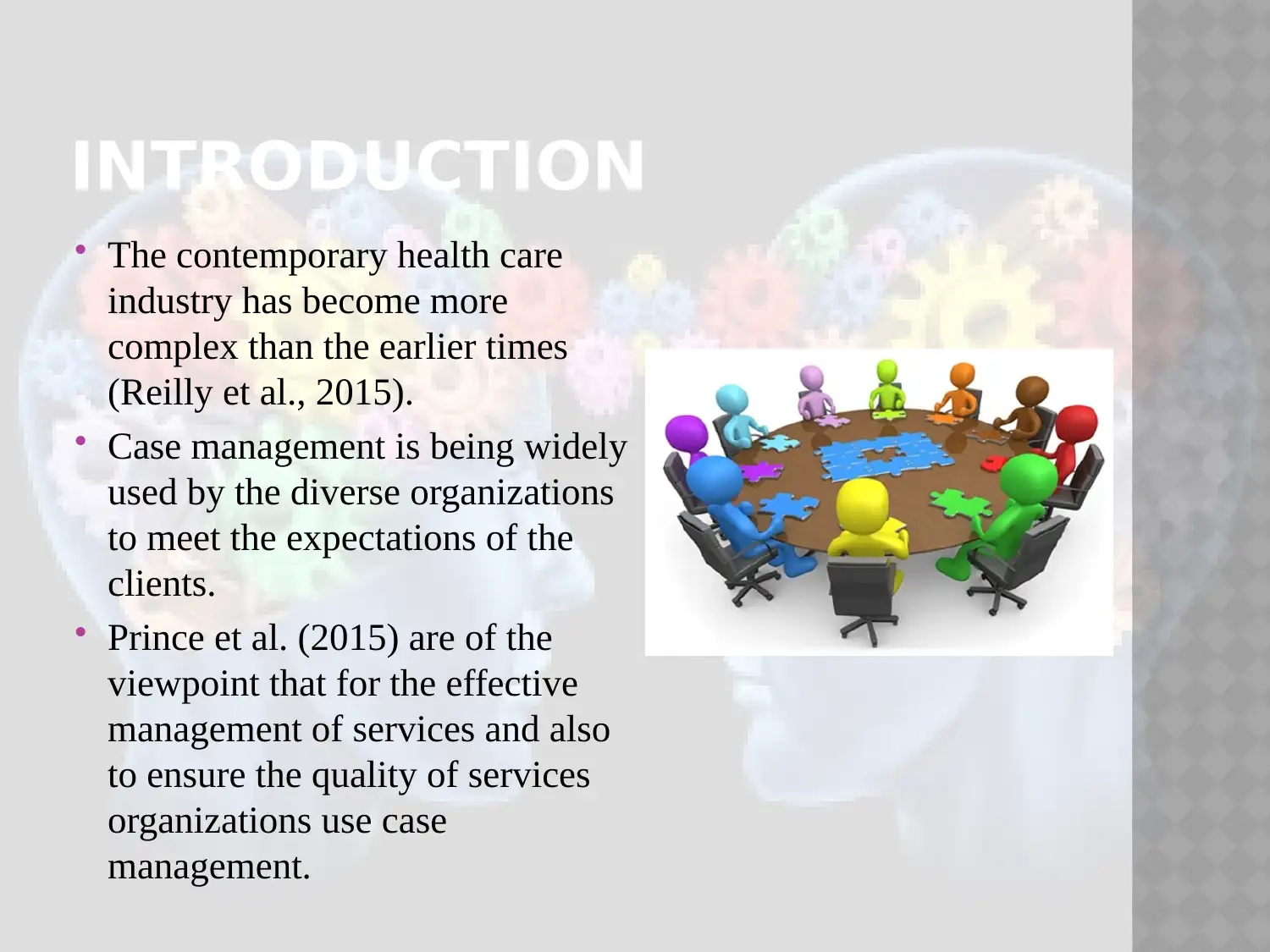
INTRODUCTION
The contemporary health care
industry has become more
complex than the earlier times
(Reilly et al., 2015).
Case management is being widely
used by the diverse organizations
to meet the expectations of the
clients.
Prince et al. (2015) are of the
viewpoint that for the effective
management of services and also
to ensure the quality of services
organizations use case
management.
The contemporary health care
industry has become more
complex than the earlier times
(Reilly et al., 2015).
Case management is being widely
used by the diverse organizations
to meet the expectations of the
clients.
Prince et al. (2015) are of the
viewpoint that for the effective
management of services and also
to ensure the quality of services
organizations use case
management.

CASE MANAGEMENT
According to Cmsa.org.au (2018),
case management is “a
collaborative process of
assessment, planning, facilitation,
care coordination, evaluation….to
promote quality cost-effective
outcomes”.
The registered nurses and other
health care professionals are
required to have “Certified Case
Manager (CCM) credential” in
order to work in the health care
organizations (Health.gov.au,
2018).
According to Cmsa.org.au (2018),
case management is “a
collaborative process of
assessment, planning, facilitation,
care coordination, evaluation….to
promote quality cost-effective
outcomes”.
The registered nurses and other
health care professionals are
required to have “Certified Case
Manager (CCM) credential” in
order to work in the health care
organizations (Health.gov.au,
2018).
⊘ This is a preview!⊘
Do you want full access?
Subscribe today to unlock all pages.

Trusted by 1+ million students worldwide
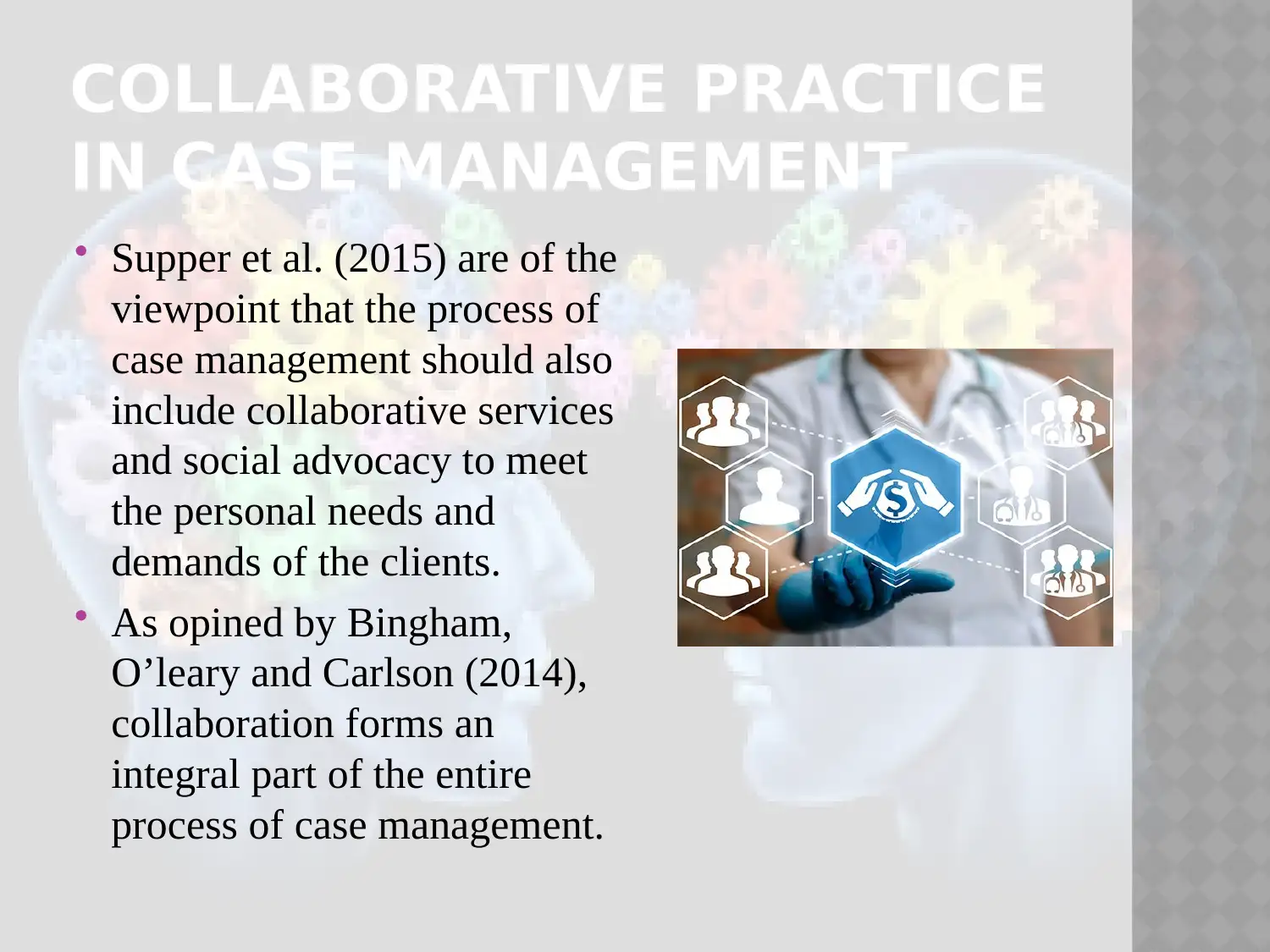
COLLABORATIVE PRACTICE
IN CASE MANAGEMENT
Supper et al. (2015) are of the
viewpoint that the process of
case management should also
include collaborative services
and social advocacy to meet
the personal needs and
demands of the clients.
As opined by Bingham,
O’leary and Carlson (2014),
collaboration forms an
integral part of the entire
process of case management.
IN CASE MANAGEMENT
Supper et al. (2015) are of the
viewpoint that the process of
case management should also
include collaborative services
and social advocacy to meet
the personal needs and
demands of the clients.
As opined by Bingham,
O’leary and Carlson (2014),
collaboration forms an
integral part of the entire
process of case management.
Paraphrase This Document
Need a fresh take? Get an instant paraphrase of this document with our AI Paraphraser
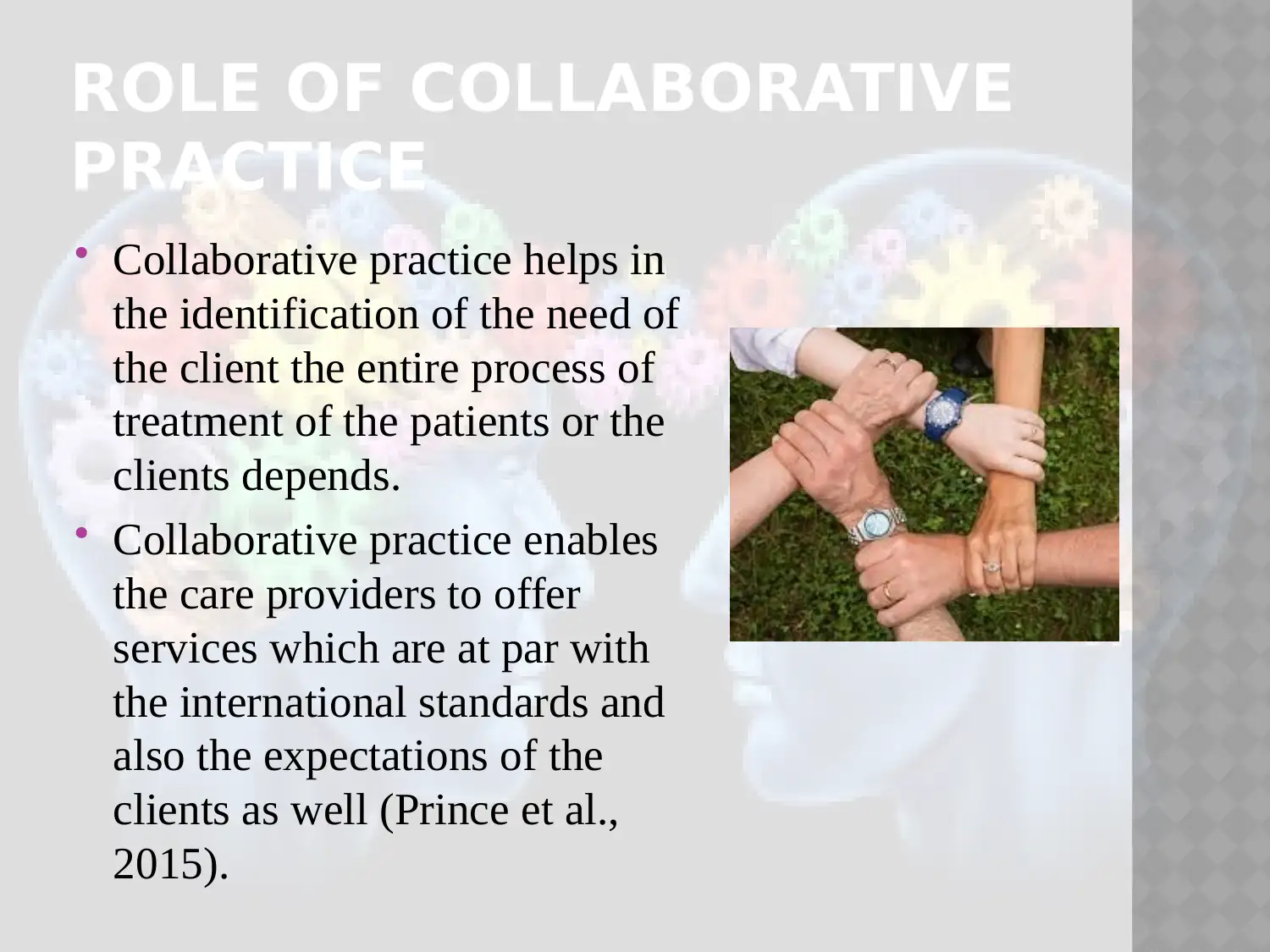
ROLE OF COLLABORATIVE
PRACTICE
Collaborative practice helps in
the identification of the need of
the client the entire process of
treatment of the patients or the
clients depends.
Collaborative practice enables
the care providers to offer
services which are at par with
the international standards and
also the expectations of the
clients as well (Prince et al.,
2015).
PRACTICE
Collaborative practice helps in
the identification of the need of
the client the entire process of
treatment of the patients or the
clients depends.
Collaborative practice enables
the care providers to offer
services which are at par with
the international standards and
also the expectations of the
clients as well (Prince et al.,
2015).
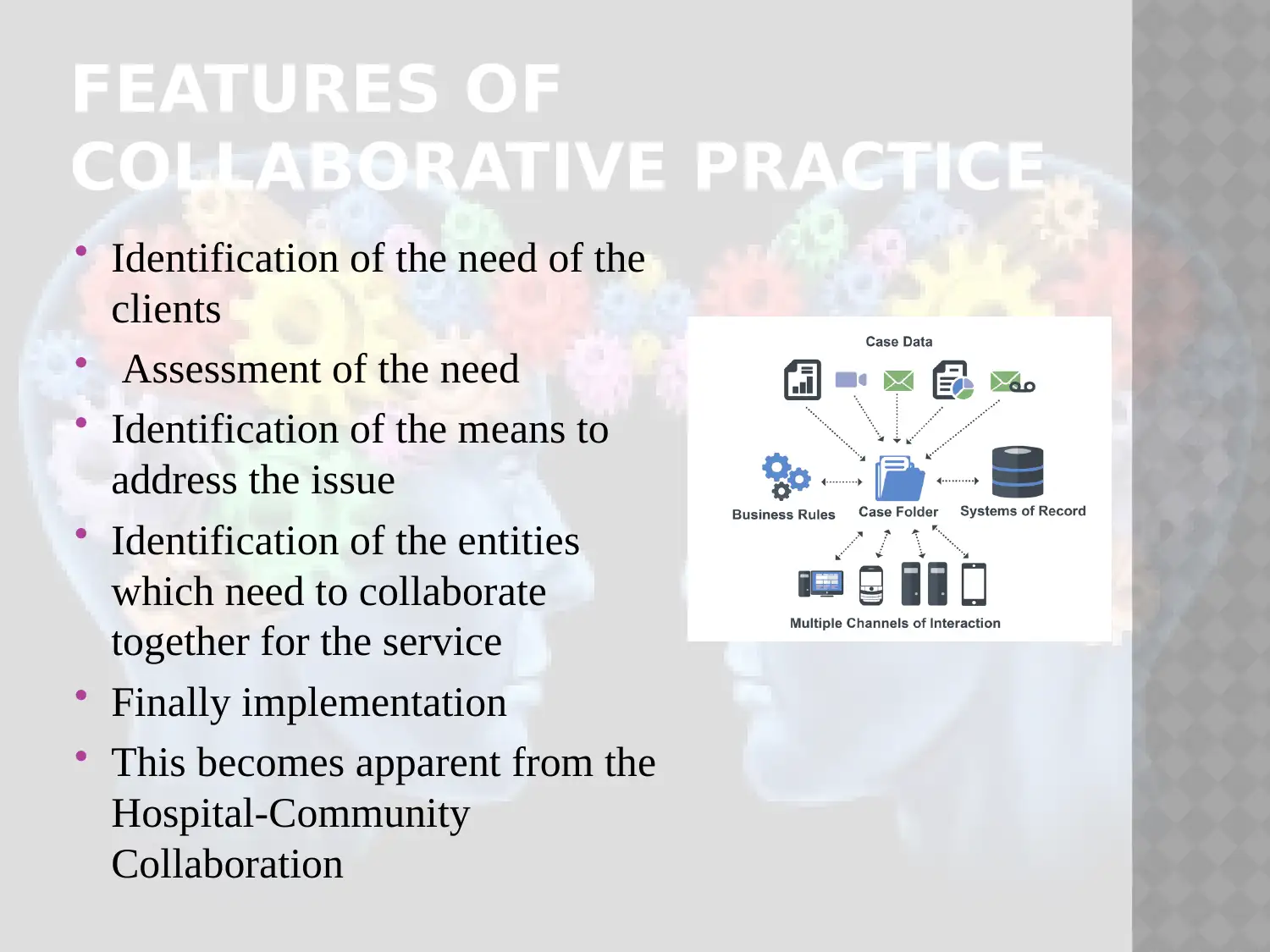
FEATURES OF
COLLABORATIVE PRACTICE
Identification of the need of the
clients
Assessment of the need
Identification of the means to
address the issue
Identification of the entities
which need to collaborate
together for the service
Finally implementation
This becomes apparent from the
Hospital-Community
Collaboration
COLLABORATIVE PRACTICE
Identification of the need of the
clients
Assessment of the need
Identification of the means to
address the issue
Identification of the entities
which need to collaborate
together for the service
Finally implementation
This becomes apparent from the
Hospital-Community
Collaboration
⊘ This is a preview!⊘
Do you want full access?
Subscribe today to unlock all pages.

Trusted by 1+ million students worldwide
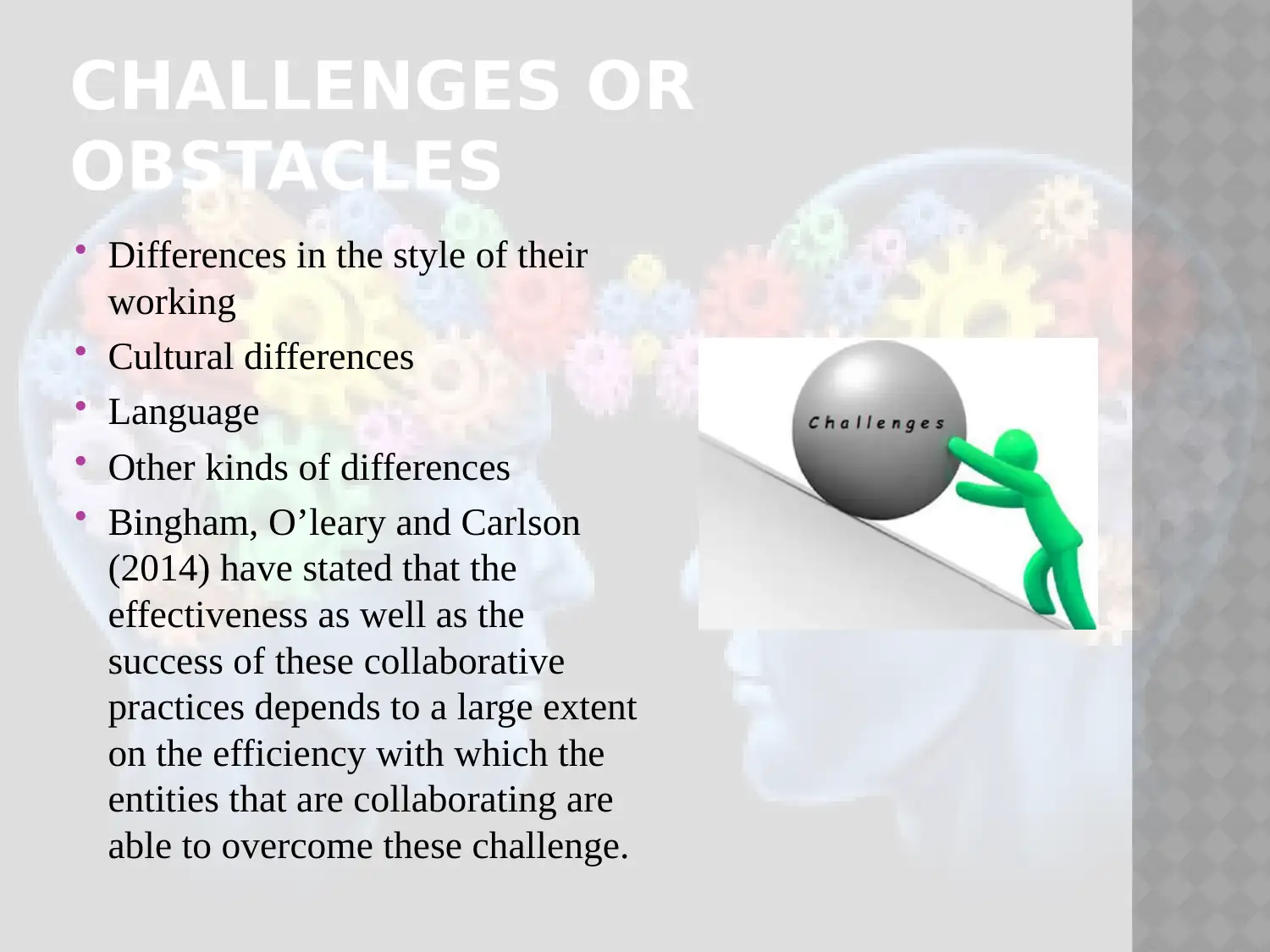
CHALLENGES OR
OBSTACLES
Differences in the style of their
working
Cultural differences
Language
Other kinds of differences
Bingham, O’leary and Carlson
(2014) have stated that the
effectiveness as well as the
success of these collaborative
practices depends to a large extent
on the efficiency with which the
entities that are collaborating are
able to overcome these challenge.
OBSTACLES
Differences in the style of their
working
Cultural differences
Language
Other kinds of differences
Bingham, O’leary and Carlson
(2014) have stated that the
effectiveness as well as the
success of these collaborative
practices depends to a large extent
on the efficiency with which the
entities that are collaborating are
able to overcome these challenge.
Paraphrase This Document
Need a fresh take? Get an instant paraphrase of this document with our AI Paraphraser
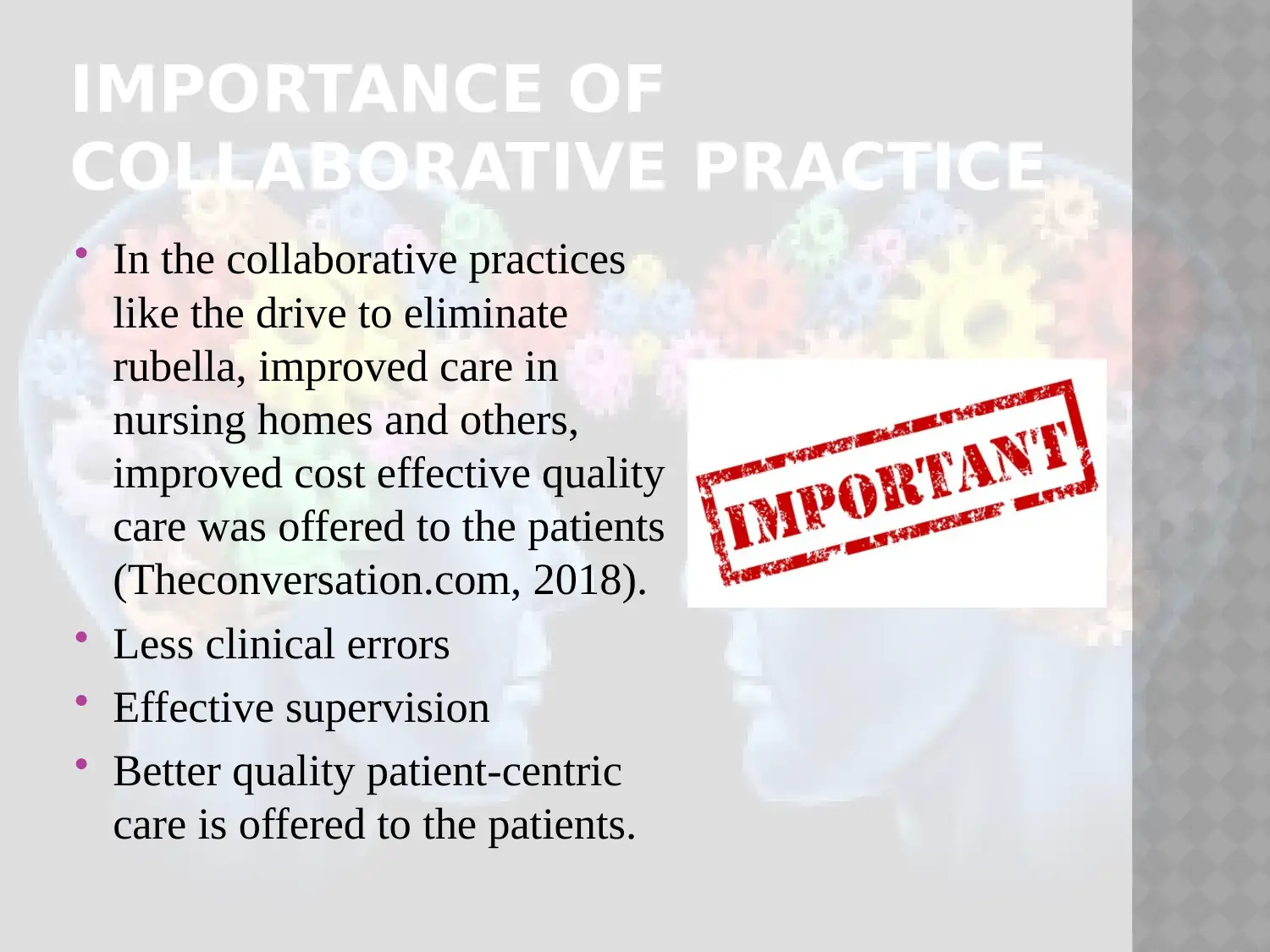
IMPORTANCE OF
COLLABORATIVE PRACTICE
In the collaborative practices
like the drive to eliminate
rubella, improved care in
nursing homes and others,
improved cost effective quality
care was offered to the patients
(Theconversation.com, 2018).
Less clinical errors
Effective supervision
Better quality patient-centric
care is offered to the patients.
COLLABORATIVE PRACTICE
In the collaborative practices
like the drive to eliminate
rubella, improved care in
nursing homes and others,
improved cost effective quality
care was offered to the patients
(Theconversation.com, 2018).
Less clinical errors
Effective supervision
Better quality patient-centric
care is offered to the patients.
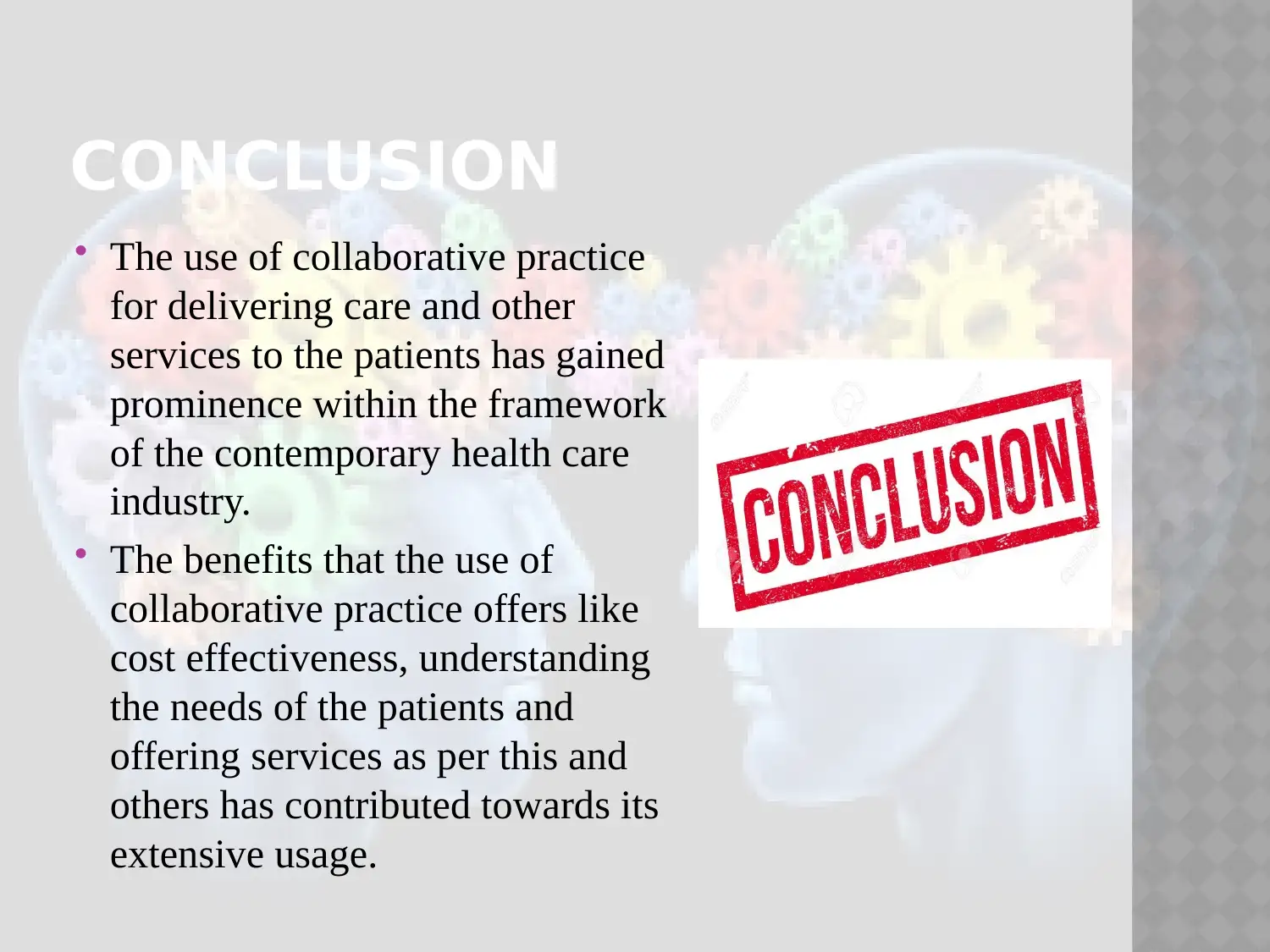
CONCLUSION
The use of collaborative practice
for delivering care and other
services to the patients has gained
prominence within the framework
of the contemporary health care
industry.
The benefits that the use of
collaborative practice offers like
cost effectiveness, understanding
the needs of the patients and
offering services as per this and
others has contributed towards its
extensive usage.
The use of collaborative practice
for delivering care and other
services to the patients has gained
prominence within the framework
of the contemporary health care
industry.
The benefits that the use of
collaborative practice offers like
cost effectiveness, understanding
the needs of the patients and
offering services as per this and
others has contributed towards its
extensive usage.
⊘ This is a preview!⊘
Do you want full access?
Subscribe today to unlock all pages.

Trusted by 1+ million students worldwide
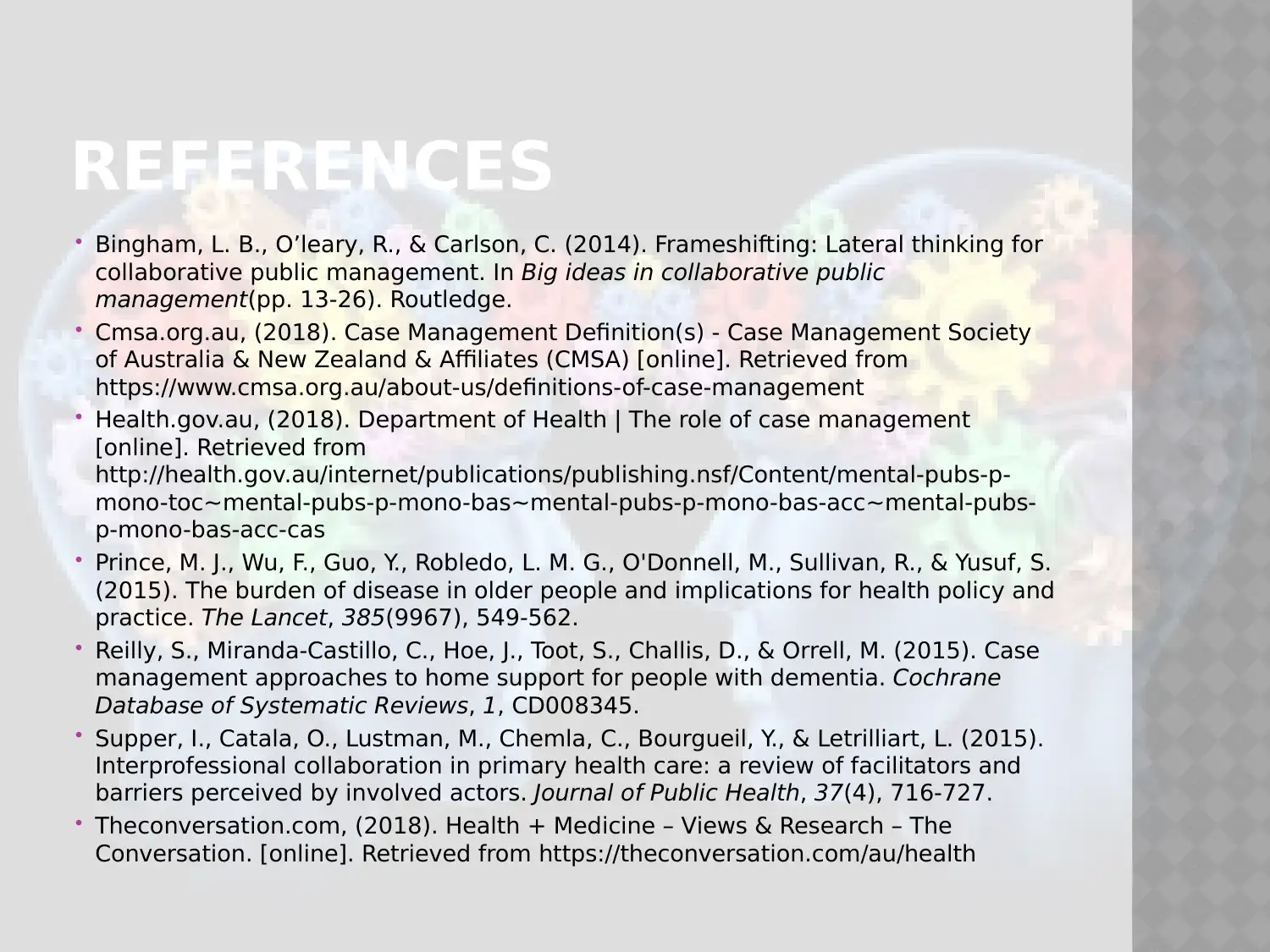
REFERENCES
Bingham, L. B., O’leary, R., & Carlson, C. (2014). Frameshifting: Lateral thinking for
collaborative public management. In Big ideas in collaborative public
management(pp. 13-26). Routledge.
Cmsa.org.au, (2018). Case Management Definition(s) - Case Management Society
of Australia & New Zealand & Affiliates (CMSA) [online]. Retrieved from
https://www.cmsa.org.au/about-us/definitions-of-case-management
Health.gov.au, (2018). Department of Health | The role of case management
[online]. Retrieved from
http://health.gov.au/internet/publications/publishing.nsf/Content/mental-pubs-p-
mono-toc~mental-pubs-p-mono-bas~mental-pubs-p-mono-bas-acc~mental-pubs-
p-mono-bas-acc-cas
Prince, M. J., Wu, F., Guo, Y., Robledo, L. M. G., O'Donnell, M., Sullivan, R., & Yusuf, S.
(2015). The burden of disease in older people and implications for health policy and
practice. The Lancet, 385(9967), 549-562.
Reilly, S., Miranda-Castillo, C., Hoe, J., Toot, S., Challis, D., & Orrell, M. (2015). Case
management approaches to home support for people with dementia. Cochrane
Database of Systematic Reviews, 1, CD008345.
Supper, I., Catala, O., Lustman, M., Chemla, C., Bourgueil, Y., & Letrilliart, L. (2015).
Interprofessional collaboration in primary health care: a review of facilitators and
barriers perceived by involved actors. Journal of Public Health, 37(4), 716-727.
Theconversation.com, (2018). Health + Medicine – Views & Research – The
Conversation. [online]. Retrieved from https://theconversation.com/au/health
Bingham, L. B., O’leary, R., & Carlson, C. (2014). Frameshifting: Lateral thinking for
collaborative public management. In Big ideas in collaborative public
management(pp. 13-26). Routledge.
Cmsa.org.au, (2018). Case Management Definition(s) - Case Management Society
of Australia & New Zealand & Affiliates (CMSA) [online]. Retrieved from
https://www.cmsa.org.au/about-us/definitions-of-case-management
Health.gov.au, (2018). Department of Health | The role of case management
[online]. Retrieved from
http://health.gov.au/internet/publications/publishing.nsf/Content/mental-pubs-p-
mono-toc~mental-pubs-p-mono-bas~mental-pubs-p-mono-bas-acc~mental-pubs-
p-mono-bas-acc-cas
Prince, M. J., Wu, F., Guo, Y., Robledo, L. M. G., O'Donnell, M., Sullivan, R., & Yusuf, S.
(2015). The burden of disease in older people and implications for health policy and
practice. The Lancet, 385(9967), 549-562.
Reilly, S., Miranda-Castillo, C., Hoe, J., Toot, S., Challis, D., & Orrell, M. (2015). Case
management approaches to home support for people with dementia. Cochrane
Database of Systematic Reviews, 1, CD008345.
Supper, I., Catala, O., Lustman, M., Chemla, C., Bourgueil, Y., & Letrilliart, L. (2015).
Interprofessional collaboration in primary health care: a review of facilitators and
barriers perceived by involved actors. Journal of Public Health, 37(4), 716-727.
Theconversation.com, (2018). Health + Medicine – Views & Research – The
Conversation. [online]. Retrieved from https://theconversation.com/au/health
Paraphrase This Document
Need a fresh take? Get an instant paraphrase of this document with our AI Paraphraser

1 out of 11
Related Documents
Your All-in-One AI-Powered Toolkit for Academic Success.
+13062052269
info@desklib.com
Available 24*7 on WhatsApp / Email
![[object Object]](/_next/static/media/star-bottom.7253800d.svg)
Unlock your academic potential
Copyright © 2020–2025 A2Z Services. All Rights Reserved. Developed and managed by ZUCOL.





